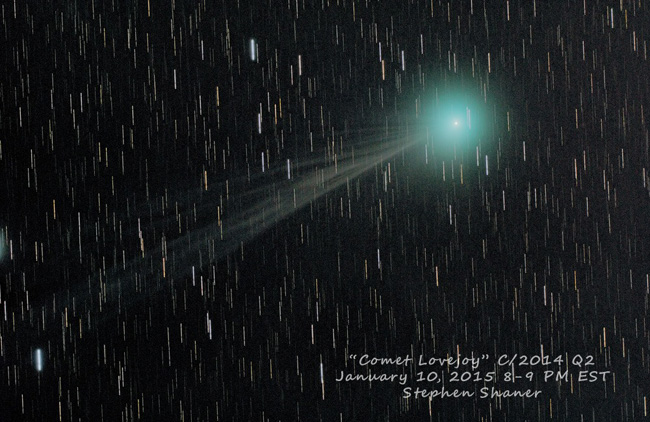
Comet Lovejoy imaged on January 10th by the ever-impressive CNY astrophotographer Stephen Shaner. From his CNYO Facebook Group post: Last night was the first in over three months it was clear enough to shoot, but it worked out well because Comet Lovejoy is at its peak. Here’s a quick process of about 40 minutes of exposures between 8-9 PM as it crossed the meridian. FOV is roughly three degrees. Distinct pale green coma in the eyepiece but unable to make out a tail or see it naked eye.
The 2015 skies are going to be full of comets. Well, at least six, to be exact, that will be either naked eye- or binocular-visible. That’s still quite a few to those keeping track! The amateur astronomy community has taken heroic efforts to scientifically identify and track new comets in the last, say, 400 years. The rise of, for instance, the Panoramic Survey Telescope & Rapid Response System (or panSTARRS) as a method for finding and tracking both comets and near-earth asteroids (or, lumped together, “objects,” for which you might hear the abbreviation “NEOs”) has greatly increased the number of accounted-for fuzzy objects in our fields of view (and provided us a giant leap in our existential risk assessment infrastructure to boot). Quite simply, we’ve more + better eyes on the skies, meaning we’re bound to continue to find more and more comets and asteroids. You can even subscribe to NASA twitter feeds that announce the passing-by of these hopefully passers-by (see @AsteroidWatch and @NasaNEOCam).
The discovery of NEOs may or may not qualify as a modern John Henry-ism, as amateur astronomers are still discovering objects at a decent pace thanks to improvements in their own optics and imaging equipment. Comet Lovejoy, C/2014 Q2, is one such recent example discovered by famed modern comet hunter Terry Lovejoy (who has five comets to his name already).
Comet Lovejoy And More In CNY
Comet Lovejoy has made the winter sky that much more enjoyable (and below freezing cold that much more bearable) by reaching peak brightness in the vicinity of the prominent winter constellations Taurus and Orion. Visible soon after sunset and before the “really cold” temperatures set in (after 10 p.m. or so), Lovejoy has been an easy target in low-power binoculars and visible without equipment in sufficiently dark skies. Now on its way out of the inner solar system, its bright tail will shrink and its wide coma (that gives it its “fuzziness”) will disappear as the increasingly distant Sun is unable to melt Lovejoy’s surface ice. Those of us who dared the cold, clear CNY skies these past few weeks were treated to excellent views, while the internet has been flooded with remarkable images of what some have described as the most photographed comet in history (a title that will likely be taken from it when a few other comets pass us by during warmer nights this year).
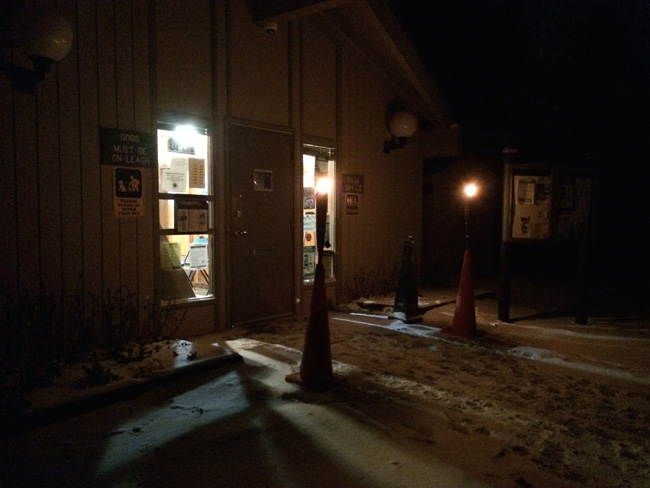
The tiki lounge at Green Lakes State Park, 9 January 2014.
The first observing session around Syracuse this year happened at Green Lakes State Park on January 9th. Bob Piekiel, one of CNY’s best known and most knowledgable amateur astronomers, had his Celestron NexStar 11 in the parking lot behind the main office, which was fortunately kept open for attendees hoping to warm up between views. To Bob’s C11 was added my Zhumell 25×100’s, providing less magnification but a wider field of view to take in more of the comet’s core, tail, and nearby stars.
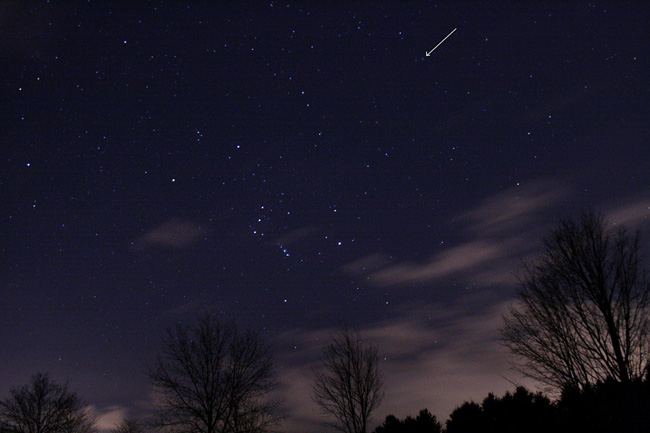
A very prominent Orion and arrow-ed Comet Lovejoy from the Green Lakes parking lot. Photo by Kim Titus.
The Friday night skies were only partially on our side, offering a few short-lived views of the Orion Nebula and Lovejoy. Jupiter was just bright enough to burn through some of the cloud cover to our East, giving us slightly muddled but otherwise decent views of it and its four largest satellites for about 10 minutes. By our 9 p.m. pack-up and departure, the skies were even worse – which is always a good feeling for observers (knowing they didn’t miss a chance for any additional views by packing up early).
The night of Saturday, January 10th turned into a much better night for observing, offering a good opportunity for some long-exposure images to try to capture Lovejoy just past its luminous prime. The following image was taken from one of the parking lots at Jamesville Beach – the same spot where Larry Slosberg, Dan Williams and I observed the nova in Delphinus. Light pollution aside from the 30 second exposure, the brightest constellations are clearly visible and a fuzzy, bright green star is clearly visible in the full-sized image. Click on the image below for a larger, unlabeled version of the same.
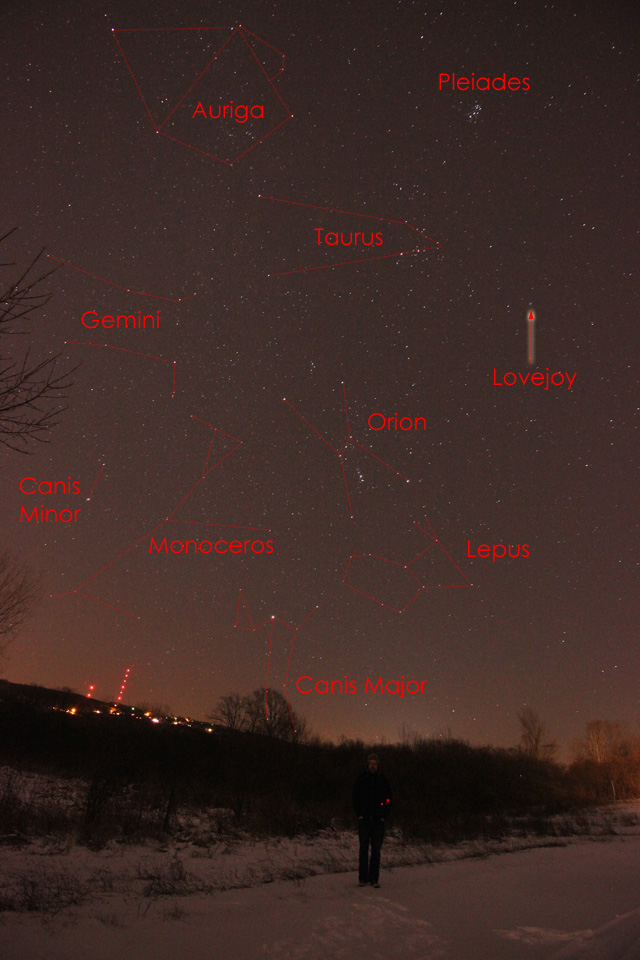
An array of Winter’s finest from Jamesville Beach, 10 January 2014, 8:00 p.m. Click on the image for a full and unlabeled version.
The imaging continued in Marcellus on January 10th, with Bob Piekiel producing a zoomed in view of Lovejoy.
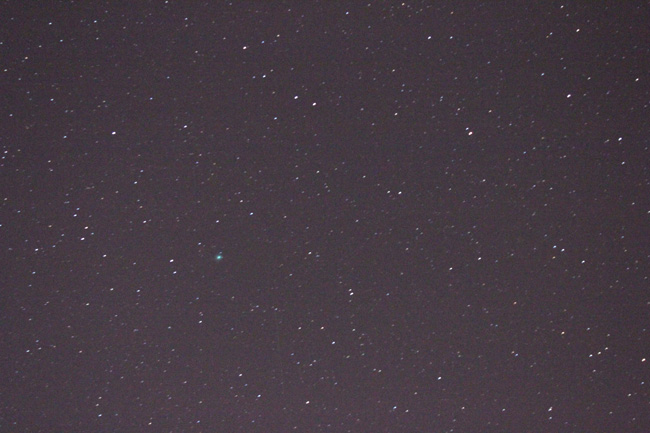
An unmistakable view of Comet Lovejoy. Image by Bob Piekiel.
As with all astronomical phenomena (excluding solar viewing, of course), the best views come from the darkest places. A third Lovejoy session was had up in West Monroe, NY on Wednesday, January 14th with fellow CNYO’er Ryan Goodson at New Moon Telescopes. Putting his 27” Dob to use, the green-tinted Lovejoy was almost bright enough to tan your retina. With dark skies and no observing line, we then attacked some subtler phenomena, including the Orion Nebula in Orion, the Eskimo Nebula in Gemini, and the Hubble Variable Nebula in Monoceros. The images below are our selfie with Lovejoy and the best of Winter, a snapshot near the zenith (with Jupiter prominent), and the Northern sky (click on the images for larger, unlabeled versions).
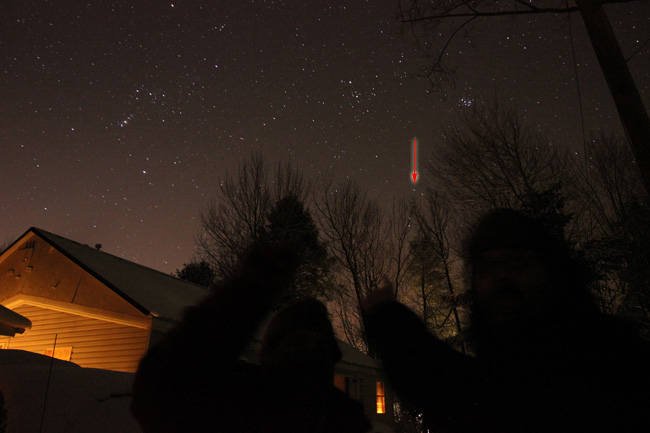
Ryan and I pose for 30 sec, our fingers completely missing the location of Lovejoy (red arrow). Click for a larger view.

Some of Winter’s finest from NMT HQ, including a prominent Jupiter just to the west of (and about to be devoured by) the constellation Leo. Click for a larger view.
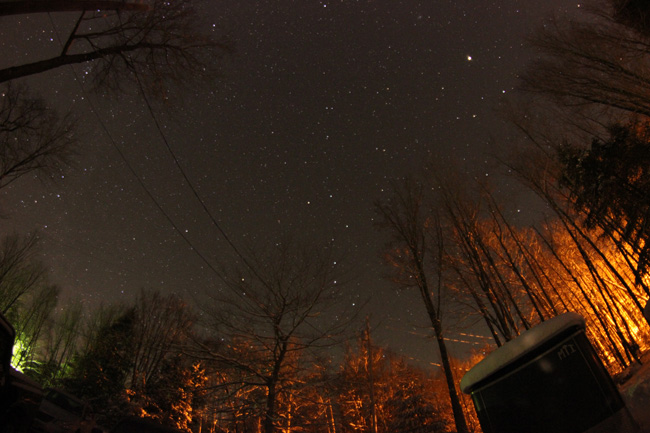
A view of NMT’s opening to the North, including Cassiopeia at left (the sideways “W”), the Big Dipper in the middle, and Jupiter at the right. Click for a larger view.
A Clothing Thought…
As we can all attest to, the nighttime temperatures this month have oscillated between bitterly cold and painfully cold. The pic of my Element’s thermometer at my midnight departure from West Monroe read -12 F (and the tire inflation warning light stayed on until I hit 81 South), yet with the exception of the tips of my toes, I wasn’t very bothered by the cold.

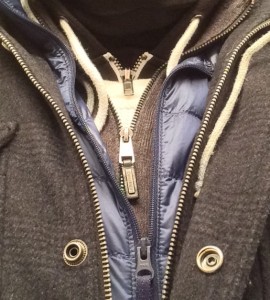 It’s one of the cold realities of amateur astronomy – you never realize how cold it can get outside until you’re standing perfectly still at a metal eyepiece. The solution is as old as the sediment-grown hills – layers! The top half of my outfit for the evening is shown below, featuring six (yes, six) layers from turtleneck to final coat. My bottom half featured three layers that decorum permits me from showing here. For those wondering how the blood still flows below the belt, the answer is simple – buy yourself an outer layer two or three sizes larger than you usually wear. In my case, my outer coat’s a bit baggy and my outer pants are a very tightly-meshed pair of construction pants with a 40” waist (from a trip to DeJulio’s Army & Navy Store on Burnet Ave. in Syracuse).
It’s one of the cold realities of amateur astronomy – you never realize how cold it can get outside until you’re standing perfectly still at a metal eyepiece. The solution is as old as the sediment-grown hills – layers! The top half of my outfit for the evening is shown below, featuring six (yes, six) layers from turtleneck to final coat. My bottom half featured three layers that decorum permits me from showing here. For those wondering how the blood still flows below the belt, the answer is simple – buy yourself an outer layer two or three sizes larger than you usually wear. In my case, my outer coat’s a bit baggy and my outer pants are a very tightly-meshed pair of construction pants with a 40” waist (from a trip to DeJulio’s Army & Navy Store on Burnet Ave. in Syracuse).
And don’t worry about color coordinating. The nighttime is the right time for the fashion unconscious.








